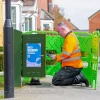Dorset UK Council Propose £5m to Extend Rural FTTP Broadband Cover
The state aid supported Superfast Dorset (SFD) project, which has so far worked with Openreach (BT) to extend the reach of FTTC/P “superfast broadband” (24Mbps+) to 97%+ of the county (including Poole and Bournemouth), has proposed a £5m extension to its existing Phase 3 contract.
The existing £7.4m Phase 3 contract is enabling Openreach (BT) to expand the reach of their Gigabit capable Fibre-to-the-Premises (FTTP) based broadband ISP network to an additional 3,800 rural home and businesses in the county, although that work is due to end this summer 2019 (here). BT committed about £3.4m to support the Phase 3 contract, with £3.9m coming from public sources (council etc.).
We know from an earlier report (here) that this will still leave upwards of 10,000 premises spread across the county (mostly in remote rural areas) in need of an upgrade so as to be put them within reach of a fixed superfast broadband network. On this point the Dorset County Council have long said that they want to get “as close as practicably possible” to 100% coverage and have been considering a Phase 4 contract (here).
Advertisement
The future Phase 4 deal is expected to harness around £10m of clawback (gainshare), which is public money that BT returns as take-up in intervention areas rises (reused to help improve coverage and speeds). However Phase 4 is still a future prospect and in the meantime the council is proposing an extension of their existing Phase 3 contract.
The original Phase 3 contract included the potential to expand its public funding contribution up to a maximum of £8.9 million (roughly a £5m boost over the £3.9m so far agreed). Part of the funding for this extra £5m is proposed to be filled by last year’s provisional award of an extra £3.7m from DEFRA’s Rural Broadband Infrastructure Fund (RBI).
Dominic Fitzgerald, Programme Manager of Superfast Dorset, said:
“The proposal for Phase 3 contract expansion via the Change Control process would require additional public funding.
This would be drawn from the £3.7M RBI grant award from DEFRA (RPA), public funding released from the initial Phase 3 build from descoped structures (structures cancelled on cost considerations, areas now provisioned by third party or other in life changes) and existing capital underspends in the SFD programme.
It should be further noted that the DEFRA grant award remains conditional pending assurance by Building Digital UK (BDUK) on behalf of DEFRA and final approval by the RPA of the modelled coverage and delivery specifics put forward under the Change Control process by Openreach.”
The conditions of the RBI grant require completed draw-down of all grant funds by December 2021, which the council said means that extending the Phase 3 contract is “the only viable mechanism for the utilisation of the RBI grant award within this timeframe.” As above, all of this remains contingent upon council agreement and approval by BDUK, RPA etc.
The council is expected to green light this project at a cabinet meeting, which is due to be held on Tuesday next week (here). Once approved the rollout itself will focus on extending “full fibre” (FTTP) cover into some of the most remote rural areas, although the additional funding may only be enough to tackle an extra 2,000+ premises (c.£2,500 per premises).
Advertisement
The final details will no doubt follow once everything has been agreed.
Mark is a professional technology writer, IT consultant and computer engineer from Dorset (England), he also founded ISPreview in 1999 and enjoys analysing the latest telecoms and broadband developments. Find me on X (Twitter), Mastodon, Facebook, BlueSky, Threads.net and Linkedin.
« Goldman Sachs and Cityfibre Sniffing Acquisition of TalkTalk’s FibreNation


















































Comments are closed